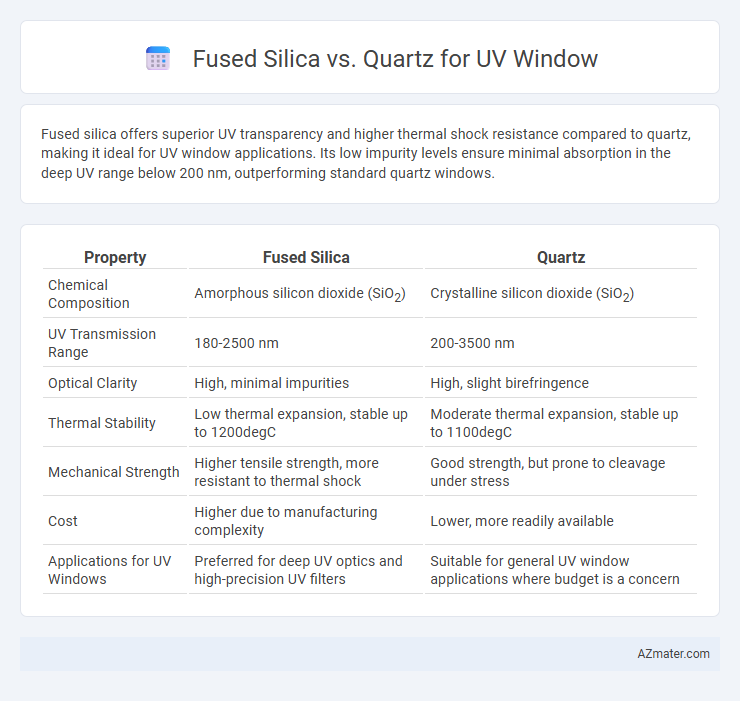Fused silica offers superior UV transparency and higher thermal shock resistance compared to quartz, making it ideal for UV window applications. Its low impurity levels ensure minimal absorption in the deep UV range below 200 nm, outperforming standard quartz windows.
Table of Comparison
| Property | Fused Silica | Quartz |
|---|---|---|
| Chemical Composition | Amorphous silicon dioxide (SiO2) | Crystalline silicon dioxide (SiO2) |
| UV Transmission Range | 180-2500 nm | 200-3500 nm |
| Optical Clarity | High, minimal impurities | High, slight birefringence |
| Thermal Stability | Low thermal expansion, stable up to 1200degC | Moderate thermal expansion, stable up to 1100degC |
| Mechanical Strength | Higher tensile strength, more resistant to thermal shock | Good strength, but prone to cleavage under stress |
| Cost | Higher due to manufacturing complexity | Lower, more readily available |
| Applications for UV Windows | Preferred for deep UV optics and high-precision UV filters | Suitable for general UV window applications where budget is a concern |
Introduction to UV Windows
Fused silica and quartz are essential materials for UV windows due to their exceptional transmission in the ultraviolet spectrum, typically ranging from 160 nm to 400 nm. Fused silica offers high purity and low impurity levels, resulting in superior UV transparency and resistance to thermal shock, making it ideal for high-precision optical applications. Quartz, with its crystalline structure, provides excellent mechanical strength and UV durability, especially in harsh environments requiring stable optical performance.
What is Fused Silica?
Fused silica is a high-purity, non-crystalline form of silicon dioxide produced by melting high-quality quartz sand, resulting in excellent optical transparency and low thermal expansion. It offers superior UV transmission down to about 180 nm, making it ideal for UV windows in applications such as photolithography and spectroscopy. Compared to crystalline quartz, fused silica exhibits better homogeneity and enhanced resistance to thermal shock, ensuring durability in demanding ultraviolet environments.
What is Quartz?
Quartz is a crystalline form of silicon dioxide known for its high purity and excellent optical clarity, making it ideal for UV windows in various applications. Unlike fused silica, which is an amorphous glass, quartz has a well-ordered crystal structure that provides superior mechanical strength and thermal stability under UV radiation. This crystalline nature allows quartz to efficiently transmit UV light, especially in wavelengths below 200 nm, making it a preferred choice for high-performance UV optics.
Optical Properties: Fused Silica vs Quartz
Fused silica exhibits superior UV transmission down to approximately 180 nm, making it ideal for deep ultraviolet applications, whereas quartz typically transmits effectively only above 200 nm. The refractive index of fused silica remains more stable across the UV spectrum, resulting in reduced chromatic aberration and enhanced image quality compared to quartz. Additionally, fused silica offers lower fluorescence under UV exposure, contributing to higher signal-to-noise ratios in precision optical systems.
UV Transmission Efficiency Comparison
Fused silica exhibits superior UV transmission efficiency compared to quartz, particularly in the deep UV range below 200 nm where quartz's transmission sharply decreases. The high purity and amorphous structure of fused silica minimize absorption and scattering, enabling transmission rates exceeding 90% down to approximately 185 nm. Quartz windows, while durable, generally transmit UV light efficiently only above 220 nm, making fused silica the preferred material for applications requiring maximum UV throughput and precision.
Thermal and Mechanical Stability
Fused silica exhibits superior thermal stability with a high softening point around 1710degC and low thermal expansion coefficient (~0.5 x 10^-6 /degC), making it ideal for UV windows exposed to rapid temperature changes. Quartz, while also transparent in the UV spectrum, has a lower thermal shock resistance and a higher expansion coefficient (~5.5 x 10^-6 /degC), which can lead to mechanical stress and potential cracking under thermal cycling. The mechanical strength of fused silica surpasses that of quartz, providing enhanced durability and longevity in harsh UV window applications requiring stringent thermal and mechanical stability.
Chemical Resistance and Durability
Fused silica exhibits superior chemical resistance compared to quartz, making it highly durable in harsh UV environments where exposure to corrosive chemicals is common. Its amorphous structure offers enhanced resistance to thermal shock and mechanical stresses, extending the lifespan of UV windows in demanding applications. Quartz, while also resistant, is more prone to microcracks and chemical etching under prolonged exposure, reducing its overall durability in comparison to fused silica.
Cost and Availability
Fused silica offers a cost-effective solution for UV windows due to its widespread availability and efficient manufacturing processes compared to natural quartz, which is more expensive and less abundant. Its consistent optical properties and high purity make fused silica the preferred material in applications requiring UV transparency without the premium cost associated with quartz. The abundant supply chain of fused silica ensures quicker delivery times and lower overall costs for UV window production in scientific and industrial use.
Typical Applications in UV Optics
Fused silica offers superior UV transmission and low thermal expansion, making it ideal for precision UV optics in lithography, laser systems, and spectroscopy. Quartz, with its excellent durability and chemical resistance, is preferred for harsh environments and UV laser windows where mechanical strength is critical. Both materials are extensively used in UV windows, lenses, and prisms, tailored to specific applications based on transmission range and environmental conditions.
Choosing the Right Material for UV Windows
Fused silica offers superior UV transmission, high thermal stability, and low coefficient of thermal expansion, making it ideal for UV windows in applications demanding precision and durability. Quartz, while similar, often contains trace impurities that reduce UV transparency and can affect performance under high-intensity UV exposure. Selecting fused silica ensures optimal performance in UV optics due to its unmatched clarity and resistance to UV-induced degradation.

Infographic: Fused silica vs Quartz for UV window
 azmater.com
azmater.com